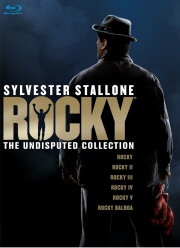- Rated PG/PG-13
- Drama
- 2009
- Buy the BD
All photos © 20th Century Fox
Reviewed by Jeff Giles
()
e’s long since been reduced to a caricature of his most successful screen persona, but beneath all the wham-bam machismo of projects like “Cobra” and “Cliffhanger” – not to mention the befuddled overreaching of misbegotten efforts like “Stop! Or My Mom Will Shoot” – Sylvester Stallone is one of the most interesting and inspiring stories in modern American cinema. And this box set, while it may not live up to its hyperbolic title, offers a powerful reminder of exactly why.
Two of the six “Rocky” movies (1976’s triple Oscar-winning first installment and 2006’s “Rocky Balboa”) have already made their first appearances on Blu-ray, and those transfers are ported directly over to this box where they’re nestled alongside the 1080p debuts of “Rocky II” (1979), “Rocky III” (1982), “Rocky IV” (1985), and “Rocky V” (1990), along with a disc devoted solely to three-plus hours of special features. Much like collections devoted to other uneven franchises (such as “Back to the Future”), it appeals to fanatics and completists by locking in a bunch of cool stuff alongside movies almost nobody wants to own – but more on that in a minute.
It’s been absorbed so thoroughly into the pop culture lexicon that it’s barely regarded as a movie anymore, but 1976’s “Rocky” won the Best Picture Oscar for a reason. Well, a lot of reasons, actually – including the rather incredible real-life story of its star and screenwriter: Stallone had just over $100 in the bank when he sold the “Rocky” script, making the movie’s tremendous success a case of life imitating art thinking wishfully. When Stallone penned the tale of a down-on-his-luck, marginally skilled boxer who gets a fluke, once-in-a-lifetime shot at going 15 rounds with the heavyweight champion, he was essentially creating his own stardom; for better or worse, almost every single one of his performances since has been an echo of Rocky Balboa, because he inhabited Balboa so thoroughly in “Rocky.” The story’s basic ingredients were played out before a single frame rolled on the first movie, and it spawned at least one dreadful sequel (not to mention, at least indirectly, crap like “Tango and Cash”), but “Rocky” is arguably the greatest underdog sports movie of all time.
If you haven’t seen it in awhile, what’s truly striking about “Rocky” is how little boxing there really is in the movie; it starts off with a small-time Balboa bout and climaxes with the title fight, and in between, there’s a whole lot of smart, tender exposition, bolstered by wonderful performances from the entire cast. He spent a lot of time trying to make audiences forget it, but Stallone carried “Rocky” on his shoulders; he’s the linchpin here, providing the muscular heart to a movie that boasts some career-defining work from Burgess Meredith and criminally underrated performances from Talia Shire, Burt Young, and Carl Weathers. If he’d never made another movie, Stallone would still be regarded as a legend.
But make more movies he did, and after stumbling with “Paradise Alley” and “F.I.S.T.,” Stallone returned to the Italian Stallion for “Rocky II,” which established what would become a pair of franchise traditions: one, it opened by replaying a few minutes from the previous film, and two, it turned Rocky into a reluctant champion, having him walk away from boxing only to be pulled back in what would be the first of many final fights. For the first sequel, at least, his reasons for stepping back into the ring are realistic and easy to understand. Having cleared a nice chunk of change for the first title bout, Rocky does what anyone in his shoes would do – namely, go on an epic shopping spree – only to discover he isn’t qualified to do anything but fight. He’s also being goaded into a rematch by Creed, who resents having to settle for the winning end of a split decision the first time around – but again, it takes most of the movie’s 119 minutes to get there, forsaking pugilistic action for the internal conflicts suffered by both men, as well as the domestic drama of Rocky’s home life, including the coma Adrian slips into after giving birth to the couple’s son.
“Rocky II” ends with Balboa defeating Creed by the narrowest possible margin, and like the first “Rocky,” it would have provided a more than suitable ending for the character’s story – but of course, it didn’t end there. In 1982, Stallone returned with “Rocky III,” which presents Balboa as a wealthy champion who’s unwittingly allowed his hunger for the fight to slip away. Like a lot of third installments, “Rocky III” is much bigger than the first two – not only does it feature more fighting, including two title bouts (as well as a ridiculous charity match between Balboa and a wrestler calling himself Thunderlips, played by Hulk Hogan), but it also pumps up the drama by killing off Meredith’s character halfway through and bringing back Apollo Creed to step in as Rocky’s trainer. It also marks the spot where the “Rocky” movies went from slightly unbelievable to all-out ridiculous, asking audiences to believe in any combination of circumstances and strategy that would allow Stallone to kick Mr. T’s ass.
Of course, if “Rocky III” is ridiculous, then “Rocky IV” is the sequel from another planet. At this point, the franchise was too big to stop, but Stallone was running out of worthwhile places to take the story – hence this installment’s showdown between Balboa and Russian prizefighter Ivan Drago (Dolph Lundgren), a towering blonde giant who packs an insane 2100 pounds of punching power. After Creed is killed in the ring during an exhibition bout with Drago, Rocky gives up his title to pursue revenge in the Soviet Union, finally venturing into the realm of nutty sports sci-fi by sending Drago down to ludicrous defeat, and then giving Rocky an unintentionally hilarious post-fight motivational speech that even makes Gorbachev clap. Though it boasts arguably the best of the series’ climactic fights, “Rocky IV” also made it perfectly clear that Stallone was running out of gas with the character – at 91 minutes, many of which are taken up with musical training montages, it’s the slimmest film in the series, and despite its blatant political subtext, it has the least to say.
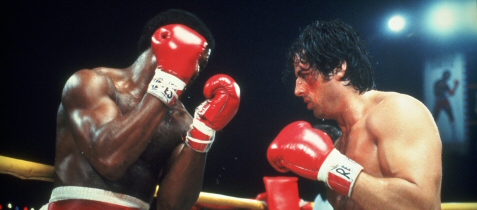
1990’s “Rocky V” could have provided a redemption of sorts for the franchise – it reunited Stallone with the director of the first film, John G. Avildsen, and took the character back to the rough Philadelphia streets he came from, forcing him to return to his old neighborhood after an unscrupulous accountant loses Rocky’s fortune. It also gives him irreversible brain damage, a bumpy relationship with his teenaged son (played by Stallone’s real-life son, Sage), and the nagging sense of emasculation that comes from having your worldly possessions auctioned off and seeing your wife have to go back to work in the seedy pet store where you met. Unfortunately, Stallone’s script didn’t stop there; knowing a “Rocky” film without some sort of brawl is no “Rocky” at all, he wrote in the character of Tommy “Machine” Gunn (real-life boxer Tommy Morrison), a hayseed fighter who nags Rocky into managing him only to abandon him for the patronage of a thinly disguised Don King clone named George Washington Duke (Richard Gant, chewing scenery like it’s Bubble Yum). Stallone intended to kill Rocky in this sequel – which sacrifices Bill Conti’s iconic score for a stack of B-level hip-hop tunes and squanders the promise of its outline – but even though he eventually chickened out, keeping Balboa alive, audiences murdered the franchise for him by ignoring “Rocky V” en masse. It was a deeply undignified end for a once-proud film saga.
Until, that is, 2006, when Stallone brought his most famous character out of mothballs for the fifth (and, God help us, final) “Rocky” sequel, the fittingly titled “Rocky Balboa.” Stripping the series and the character back to its core components, this outing gives us Rocky as an arthritic restaurateur grappling with Adrian’s death from cancer as he struggles to build a relationship with his distant son (Milo Ventimiglia). The circumstances that draw Rocky back into the ring for an exhibition bout with heavyweight champ Mason “The Line” Dixon (real-life boxer Antonio Tarver) are as ridiculous as you’d expect for a fight between opponents with a nearly 30-year age gap, but it avoids the bloat that slowly enveloped the franchise during its third, fourth, and fifth installments. As much as people snickered when they heard “Rocky Balboa” was heading to theaters, it ended up being a surprising critical and commercial hit; in fact, it’s arguably the second-strongest entry in the series. More than a few fans will skip straight from “Rocky IV” to “Rocky Balboa” without missing a thing.
The 1080p transfers for each of the films are roughly as strong as you’d expect, which is to say they correspond with the age of the source material (and, it must be said, the dwindling financial resources of the perpetually teetering-toward-bankruptcy MGM). “Rocky” and “Rocky II” suffer from an almost constant flurry of film artifacts – there’s a lot of grain, which you’d expect, but there are also a lot of dirt specks and scratches. “Rocky III” was originally filmed using a lot of artier tricks, including a number of soft-focus shots and diffusion filters, which leaves its transfer looking rather soft in spots. Things don’t really start to sharpen up until “Rocky IV,” which boasts a fairly flawless picture with vibrant colors and deep blacks; in contrast, “Rocky V” feels cheap and almost unfinished, but “Rocky Balboa” – again, as you’d expect, given its recent vintage – brings things back with the sharpest picture of the bunch.
The seventh and final disc collects a stack of bonus features, many of which appeared on the double-disc “Rocky” release – decision made even more disappointing given the loss of the commentary tracks included on that DVD. Still, despite its flaws, “The Undisputed Collection” does give Rocky-holics plenty of extra stuff to pore over, including “In the Ring,” a fascinating documentary that details the making of the series (particularly its first installment) via interviews with most of the creative principals, including Stallone, Shire and Young. Though “In the Ring” is the disc’s main draw, it also features an array of behind-the-scenes featurettes, interviews with boxing legends Bert Sugar and Lou Duva, tributes to Burgess Meredith and cinematographer James Crabe, Stallone’s 1976 appearance on Dinah Shore’s show, and a look at Rocky’s opponents (which does not, unfortunately, include an interview with Mr. T).
Is it worth the almost $100 MSRP? If you’re a diehard fan of the series, the answer is obviously yes; even though you’re forced to swallow “Rocky V” along with the rest of the films, it’s actually a little better than you might remember – and even the excessively slick “Rocky III” and “Rocky IV” land their punches successfully, more often than not. And at the $50 it’s currently going for at Amazon, “The Undisputed Collection” is a steal, as well as a no-brainer gift for dads all across America this holiday season. Chances are, you’ve forgotten what made the “Rocky” movies great, and how even though we knew what was coming, their final moments always filled moviegoers with inspiration and adrenaline. They’ve got their flaws, but these discs will make you feel that rush all over again.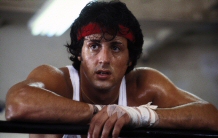 |
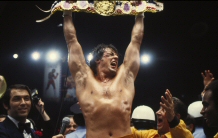 |
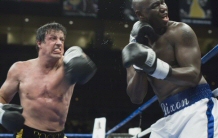 |
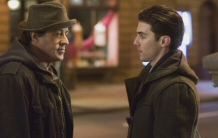 |
You can follow us on Twitter and Facebook for content updates. Also, sign up for our email list for weekly updates and check us out on Google+ as well.












